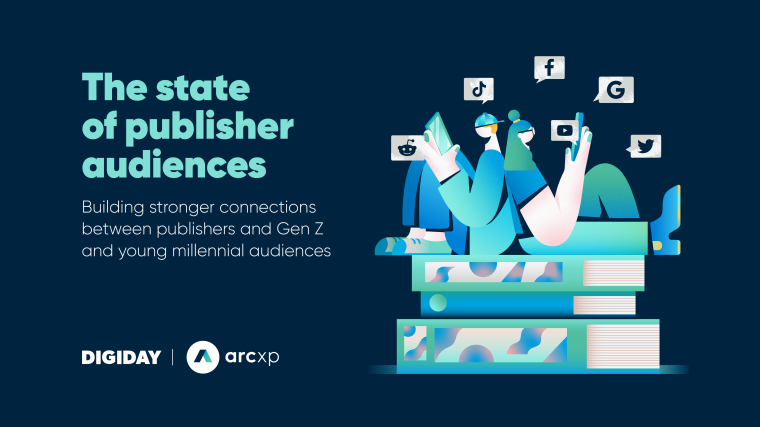
- 01 Why publishers are working to acquire and retain younger audiences
- 02 Framing factor: Publishers are engaging Gen Z and young millennial audiences at scale
- 03 The distribution equation
- 04 Traffic report: Publishers' and younger audiences' views of top channels differ in 2023
- 05 Engagement frequency by channel
- 06 Gen Z and young millennials continue to prefer short-form videos (but they're also readers)
- 07 Gen Z and young millennials say publishers mostly get their views and values
- 08 When publishers miss the mark on representation, younger audiences say it's about diversity and politics
- 09 Publisher confidence is high but challenges indicate room for improvement
This State of the Industry report, sponsored by Arc XP, dives into how publishers are adjusting strategies to gain and retain the attention of both Gen Z and younger millennial audiences to secure the newest generation of media consumers.
For publishers and media companies, focusing on younger audiences is essential to their future growth, especially as Gen Z (16–25) and young millennials (26–32 years old) increase their media consumption. Each must identify how their content — and the advertising that supports it — can effectively engage and stay relevant to the evolving preferences, values and behaviors of their newest generations of readers, viewers and listeners.
However, engaging these two generations is increasingly challenging; Gen Z and young millennials are more highly educated than past generations and are opinionated — sharing views on political and social issues within the content they consume and the platforms they use. Media companies must also incorporate these factors into their publishing strategies, keeping pace with how these audiences engage — and always doing so with authenticity. Editorial and marketing teams that fail to adapt will be left behind.
“They [Gen Z] are a smart generation and can see through an ad that is not a relatable tone with them,” said Jennifer Geller, head of brand partnerships at Jellysmack, in a recent Digiday article. “They want authenticity, credibility, truth and honesty.”
To help media companies in their quest to engage younger audiences, Digiday and Arc XP surveyed 116 publishers and 114 Gen Z and young millennial consumers to understand the tactics publishers are currently using to attract these generations and how those match up with these audiences’ preferences.
Ad position: web_incontent_pos1
Surprisingly, some of our publisher respondents favored channels and formats that weren’t at the top of the preferred list for our consumer respondents, indicating missed opportunities to engage these younger audiences.
With the help of expert insights, this new State of the Industry report explores what respondents had to say about audience and content, tactics and outcomes and what’s next as publishers work to earn and keep the attention of the next generation of media consumers.
First, the primary challenge is not that publishers need to find their Gen Z and young millennial audience; our respondents said they’ve done that to a significant extent.
Nearly half (47%) of publishers say Gen Z makes up 41% or more of their digital audience, and more than half (51%) say young millennials consist of 41% or more of their audience.
Ad position: web_incontent_pos2
These younger generations comprise a large portion of the publisher’s audience, but keeping them engaged and loyal means understanding their preferences, meeting their expectations and finding them in the right channels.
Reaching target audiences takes planning, and our respondents differed somewhat on how they get content into the channels they’re engaging, but mostly there’s an even split in terms of approach.
About one-third (34%) of our publisher respondents said their teams finish the piece of content and then pick a distribution approach. An equal amount (34%) said they decide how they’ll distribute the content ahead of time during its planning phase. And then, a similarly close percentage (31%) publish the story to their website and then discuss distribution to follow.
“This process, in my mind, should be largely distribution-agnostic,” said Miki King, president of Arc XP. “Is this good content? Is this what you believe your audiences care about? Do you have reason to believe this is a topic that your audiences care about? If you can answer that question affirmatively, I think that the even split makes sense; it’ll be the rising tide that raises all boats.”
Media companies are taking note as Gen Z and young millennials become more involved in political and social issues and establish themselves in the workplace. These generations, and Gen Z specifically, are tech-savvy and mobile-first, with high standards for how they spend time online.
As such, publishers are working to establish better methods for capturing Gen Z’s and young millennials’ attention to build long-term relationships based on what they’re learning about what each demographic wants. Key to success in that effort — is the channel itself.
Regarding digital audiences, our publisher respondents preferred Facebook, with 75% using the platform. Twitter and YouTube were next at 65% and 63%, accounting for the top three channels identified.

Similarly, in trying to reach Gen Z and young millennials specifically, our publisher respondents are seeing positive results from Facebook (66%) and then a virtual three-way tie between Twitter (48%), YouTube (47%) and TikTok (47%).
“Publishers need to focus on the consumer responses. I think that there was a time when I would have expected Facebook to be at the top of this list [for consumers]. I largely think that the numbers you’re seeing from publishers might be because the data analysis they have has not caught up to where the consumer audience is right now.”
Miki King, president of Arc XP
However, that overall strategy for reaching the younger generations could require refinement. For example, when Gen Z and young millennial respondents told us which channels they prefer, Facebook and Twitter came in at 39% and 32%, while YouTube topped the list of preferred channels at 61%.
When younger audiences consume news specifically, YouTube remains the top channel (42%), but Facebook and Twitter sank to fifth and seventh place on our younger generations’ list of preferred channels.

When it comes to the channels that pull Gen Z and young millennial respondents back to publishers’ sites more than once a day — whether for news or entertainment — the latter led at 46% for multiple visits. In either category, however, daily or more than daily visits accounted for more than 60% of our respondents’ behaviors.

Preferences are one thing, and actions are another. The chart below illustrates how different channels inspire Gen Z and young millennial consumers to click to other sites. YouTube is still at the top at 41%, while Facebook (25%) and Twitter (24%) are still lower, fifth and sixth on their list.
What causes these differences? While publishers are bullish on channels such as Facebook — where they say they see positive outcomes at scale — Gen Z and young millennials appear to have a significantly different short list of go-to channels. These younger generations prefer channels like mobile apps (49%) and email (47%), which register much lower — fifth and seventh place, respectively — on our publishers’ list of most effective channels.
According to Miki King, president of Arc XP, one answer may be in how publishers analyze the data that is telling them which channels work.
“Publishers need to focus on the consumer responses,” King said. “I think that there was a time when I would have expected Facebook to be at the top of this list [for consumers]. I largely think that the numbers you’re seeing from publishers might be because the data analysis they have has not caught up to where the consumer audience is right now.”
Another example helps support King’s assessment. For instance, GWI finds that 71% of podcast listeners are either millennials or Gen Z. However, in our survey, only 13% of publisher respondents indicated that it’s a powerful channel for these younger audiences. The question becomes, if so many younger listeners are in this channel, as GWI’s findings suggest, why aren’t publishers seeing corresponding inbound traffic — and why would only 24% of our Gen Z and young millennial audience cite podcasts as a preference?
“I do think that across the course of the next couple of years, there is going to be a bit of a correcting in the podcast market to understand that it’s really flooded,” said King. “I think as we come into 2024, there will have to be a real analysis of what the podcast market really is — is it a lot of content for the sake of content? Or, is it a lot of content that audiences and listeners are really deriving a lot of value from? I think that’s a question that still has to be answered. And I think the discrepancy in this data really speaks to that and confirms that there is still a big unknown there.”
As for how publishers can resolve this disconnect, King suggests looking into subsegments within preferred channels that may give insight into specific format preferences — a daily news briefing, a binge-worthy series and the genres into which those fall. While those are both types of podcasts, they each come with differences that attract different audiences, and therein might lie the disconnect seen in the data.
Once the channels publishers use have driven Gen Z and young millennial audiences to their site, our respondents said the most effective content formats for engaging those audiences include short-form video (78%) and a combination of text and video (62%).
The top two formats — short-form video and a combination of text and video — echo the trends seen among Gen Z and line up with the preferred content formats among the Gen Z and young millennial consumers surveyed. The top choice was short-form video at 61%, with short-form text coming in second with 40% and long-form text in third with 32% — the latter is a notable difference from what our publisher respondents said.
While Gen Z has undoubtedly been widely touted as the generation with an 8-second attention span, according to research from Sparks & Honey, the second and third format choices in the chart above tell a different story. Gen Z and young millennials like to read and even don’t mind long-form text, despite what the internet has widely publicized about them — and this is good news for publishers, especially those publishing words over video.
As for how media companies measure the effectiveness of these content formats, social-specific engagement metrics top our publishers’ list at 67%, with new subscriber rate and page views close behind at 60% each.

The following chart shows that by far, our respondents are measuring the success of their overall strategies for securing younger audiences by the average age of overall readers and subscribers at 42%.
It’s certainly easy to say all these metrics are critical. One note, however, is that the impact of publishers’ work across social media is clear when evaluating those channels themselves — they essentially stand on their own. So, with this in mind, when measuring the success of attracting and engaging younger audiences, it comes down to the average age of readers and subscribers.
Gen Z and young millennials represent an outsized percentage of our publishers’ audiences, and they engage with content on these channels many times a day. Publishers who reflect this audience’s views and values will keep them and grow new segments of younger readers, viewers and listeners.
The good news is, regarding the way our Gen Z and young millennial respondents evaluated the news and entertainment content channels they’re using, publishers are hitting those marks very well 38% of the time and at least somewhat 50% of the time — in other words, 88% of the time their publishers of choice are showing some element of what matters to them.
The ways publishers succeed with Gen Z and young millennials include often or always representing their age group (32%) while also representing diverse age demographics overall (26%). Interestingly, 21% said their political views were well represented, but only 11% said so regarding ethnically diverse demographics and 5% for LGBTQ+ demographics.
The flip side of those last two observations shows up near the top of our younger respondents’ stated areas needing improvement — 23% said publishers rarely or never represented ethnically diverse demographics, and 23% said the same about the representation of LGBTQ+ demographics. The top reason publishers are missing the mark on representing values and news: 31% said publishers rarely or never publish or post content representing their political views.
The ways in which publishers are working to know more — and do more — about representing the views and values of Gen Z and young millennial audiences, plus glean insights about preferences overall, start with monitoring comment feeds on websites and across social media (31% said so in our survey). But then they’re also hiring from the demographics they want to represent (31%), adding Gen Z and young millennial expertise and perspectives to their ranks.

“I think it’s really important to embed audience development and strategy into the overall strategy. I think it’s necessary to understand Gen Z and the span of millennial audiences, and the needs of each stage of each generation — not every segment of the millennial population is homogeneous. And, having a diversity of voices and generations at the table as you’re making these decisions is really critical.”
Miki King, president of Arc XP
Our Gen Z and young millennial audiences tell us publishers are mostly doing the right things in this regard. For example, listening to the feeds and comments sections topped their list (by a significant majority: 61%). Hiring wasn’t quite as crucial as surveys. The younger generation wants direct input, but they don’t want to click in to give it.
On another note: among our publishers, 4% are taking no specific measures. Another respondent answered “Other” and said their company used to have a team tasked with engaging a younger audience but eliminated that group. King says this is not a good idea for those not yet taking steps to include Gen Z and young millennials’ views in their organizations.
“I would advise against that,” she said. “I think it’s really important to embed audience development and strategy into the overall strategy. I think it’s necessary to understand Gen Z and the span of millennial audiences, and the needs of each stage of each generation — not every segment of the millennial population is homogeneous. And, having a diversity of voices and generations at the table as you’re making these decisions is really critical.”
The opportunities for engaging Gen Z and young millennials are plentiful, and the media companies that execute well will reap long-term rewards.
Regarding reaching and engaging younger audiences overall, most of our respondents gave themselves a passing grade. In our survey, they said their current tactics for attracting younger audiences have been effective (87% agree or strongly agree).
“That’s a metric that is somewhat surprising to me,” King said. “As a whole, the industry is still trying to understand how to connect with younger audiences.”
The issue may be definitional.
“I think just about everyone is still cracking the code on what that looks like,” she continued, “and I think that this question was, in many ways, easier to answer three or four years ago than it is now. I think we were at some point living in a different time where politics was pop culture, and I think that has shifted. I think we are still working through various ways of what ‘effective’ looks like.”
And our publisher respondents said there are struggles in play. For example, 57% said obtaining information about Gen Z and young millennial audiences is challenging. Parsing the social media landscape and knowing which channels they’re supposed to emphasize, 44% cited this as a challenge. Production also presents obstacles (audio and visual steps were cited by 40%).
The most-cited challenges here will likely be solved by hiring more workers within these demographics, surveying them specifically, or leaning on third-party research. And while nearly one-third of publisher respondents are working on hiring more Gen Z and young millennial individuals, as we saw in earlier sections of this report, fewer are engaging in surveying (13%), and only 3% said they were using third-party research.
“I think that the pandemic changed the type of information we want to consume, how we want to consume it, and the velocity at which we want information coming to us,” King said. “From a technology standpoint, I think publishers have to be willing and able to observe and ask what tools are available today and what’s different from what was available three or four years ago. I think that Gen Z is going to point them in the right direction, but they have to be ready to listen and tune in to what today’s younger audiences are signaling.
“Publishers need to come together on a quarterly or six-month basis to understand what it is that they are doing to speak to this audience today,” he continued, “Not, ‘we launched this thing 18 months ago, and it did really well.’ That won’t cut it anymore. They need to be thinking on a six-month basis in terms of how to attract these audiences, and I think that structuring the decision-making and the conversation to include those voices is critical.”
“Talent is key,” said King. “Who publishers hire and who they have at the table making decisions have to reflect the audiences they wish to serve.”
As publishers assess how Gen Z and young millennial audiences’ preferred channels and content formats stack up, they’ll continue to adjust their strategies and investments. To ensure these Gen Z and young millennials are well-engaged, publishers must serve them the desired content in the formats they wish to see it in. And with this may come a need to shift the type of technologies or skills the team is investing in and the expertise being brought on board.
The teams that keep these necessities in mind — as they evaluate how to close the gap between their creators and the audiences they want to reach — will win the long-term loyalty of the younger audiences they acquire, retaining those eyes, ears and minds for the future.


